Optimizing Network Infrastructure for Cookie Corporation
VerifiedAdded on 2020/05/11
|8
|2393
|32
AI Summary
Cookie Company faces significant challenges with its current network setup, prompting a strategic shift to modernize infrastructure. This report examines several core aspects: the adoption of an innovative unified communication system, the design and implementation of local and wide area networks in headquarters and branches, and optimal WAN media usage for seamless connectivity. Additionally, it explores effective domain name systems (DNS) and IP address management techniques while recommending advanced network services like VoIP and efficient data processing models such as peer-to-peer systems. The goal is to provide a detailed roadmap that not only addresses existing challenges but also positions Cookie Company for future technological advancements.
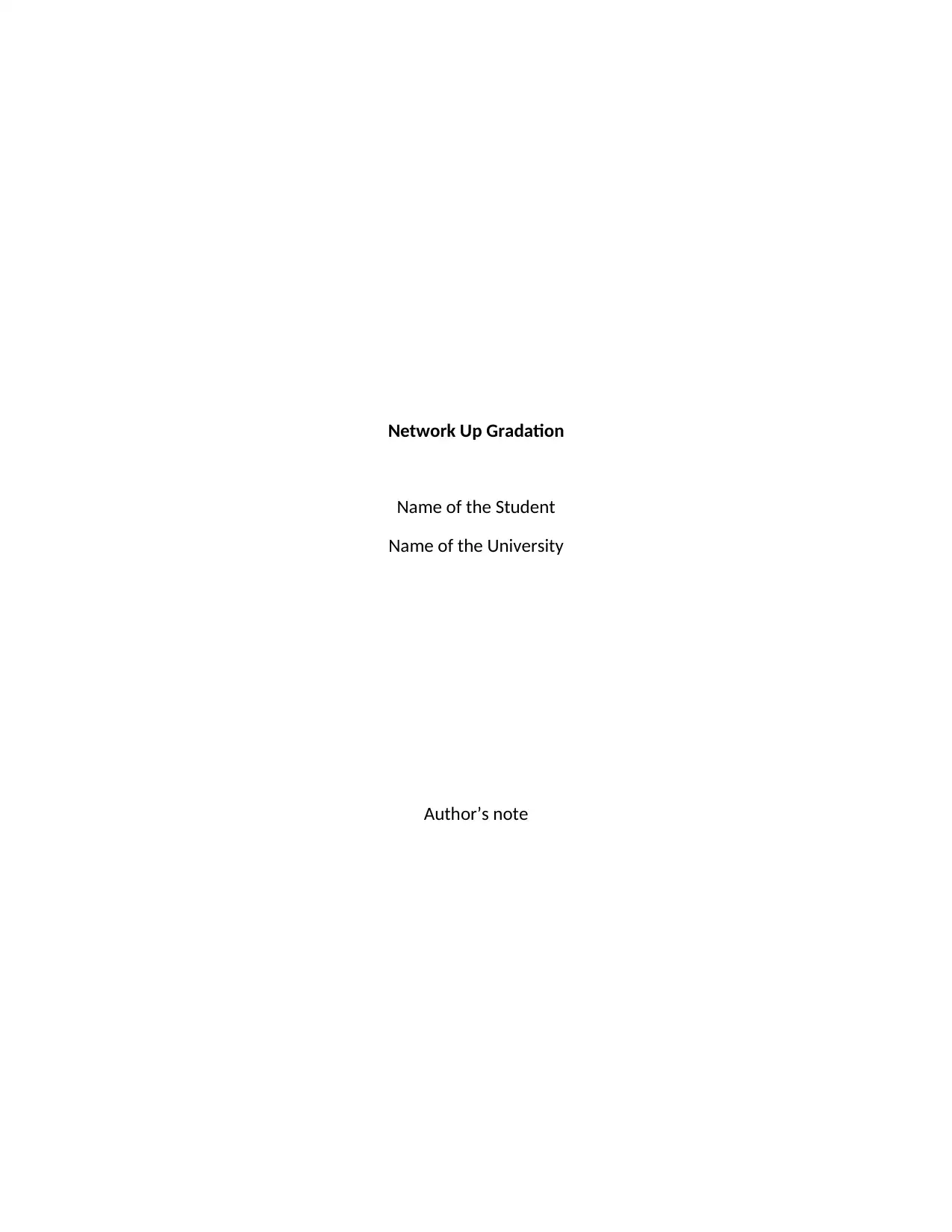
Network Up Gradation
Name of the Student
Name of the University
Author’s note
Name of the Student
Name of the University
Author’s note
Paraphrase This Document
Need a fresh take? Get an instant paraphrase of this document with our AI Paraphraser
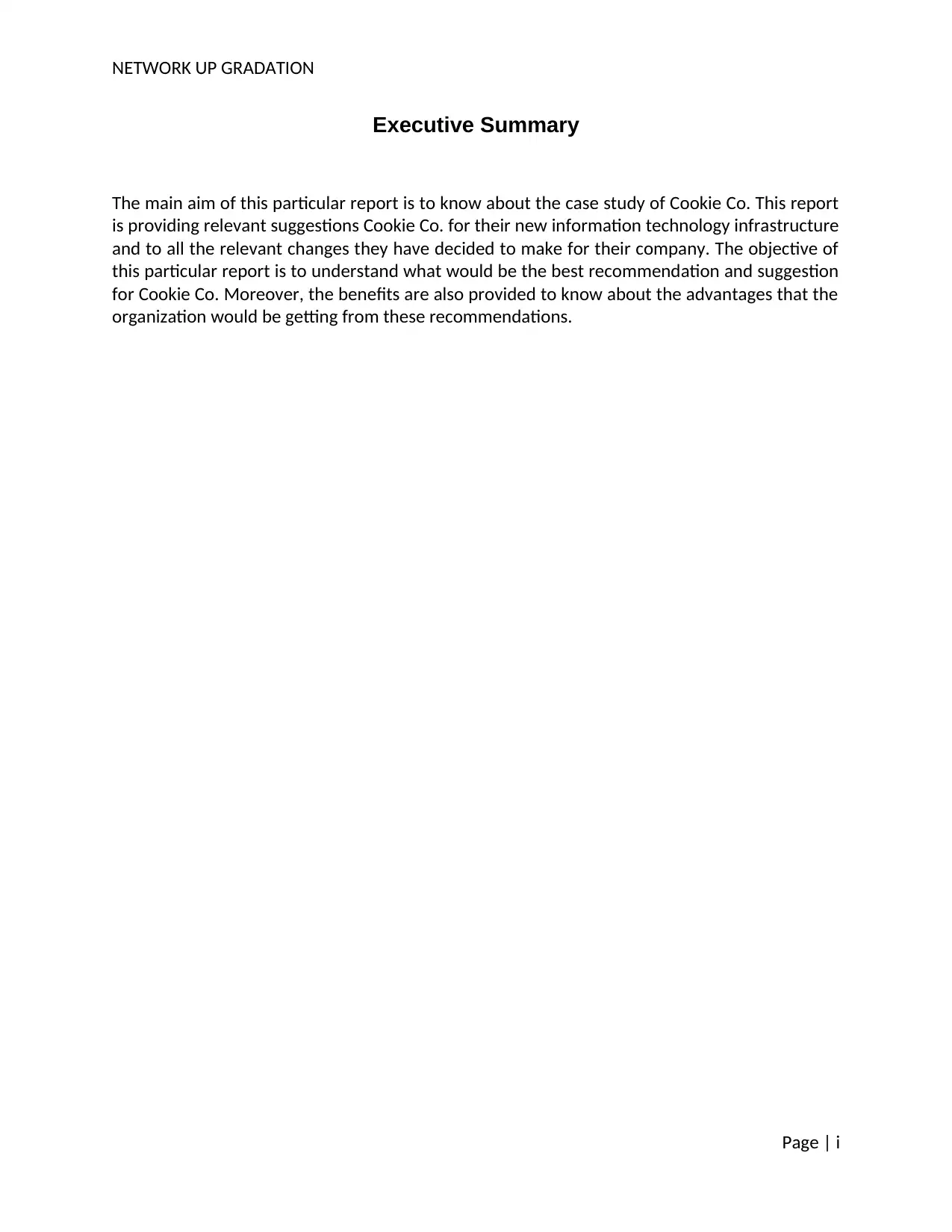
NETWORK UP GRADATION
Executive Summary
The main aim of this particular report is to know about the case study of Cookie Co. This report
is providing relevant suggestions Cookie Co. for their new information technology infrastructure
and to all the relevant changes they have decided to make for their company. The objective of
this particular report is to understand what would be the best recommendation and suggestion
for Cookie Co. Moreover, the benefits are also provided to know about the advantages that the
organization would be getting from these recommendations.
Page | i
Executive Summary
The main aim of this particular report is to know about the case study of Cookie Co. This report
is providing relevant suggestions Cookie Co. for their new information technology infrastructure
and to all the relevant changes they have decided to make for their company. The objective of
this particular report is to understand what would be the best recommendation and suggestion
for Cookie Co. Moreover, the benefits are also provided to know about the advantages that the
organization would be getting from these recommendations.
Page | i
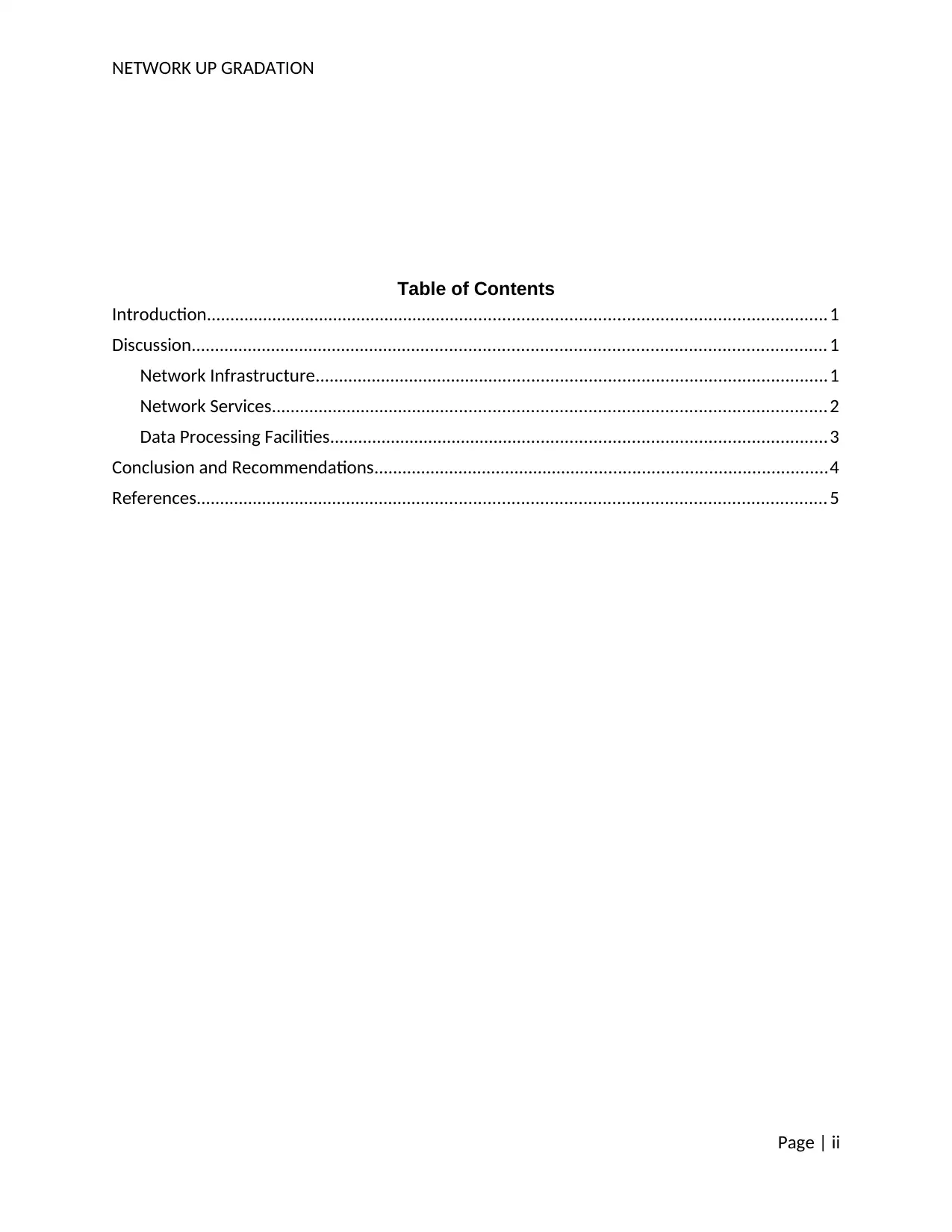
NETWORK UP GRADATION
Table of Contents
Introduction...................................................................................................................................1
Discussion...................................................................................................................................... 1
Network Infrastructure............................................................................................................1
Network Services..................................................................................................................... 2
Data Processing Facilities.........................................................................................................3
Conclusion and Recommendations................................................................................................4
References..................................................................................................................................... 5
Page | ii
Table of Contents
Introduction...................................................................................................................................1
Discussion...................................................................................................................................... 1
Network Infrastructure............................................................................................................1
Network Services..................................................................................................................... 2
Data Processing Facilities.........................................................................................................3
Conclusion and Recommendations................................................................................................4
References..................................................................................................................................... 5
Page | ii
⊘ This is a preview!⊘
Do you want full access?
Subscribe today to unlock all pages.

Trusted by 1+ million students worldwide
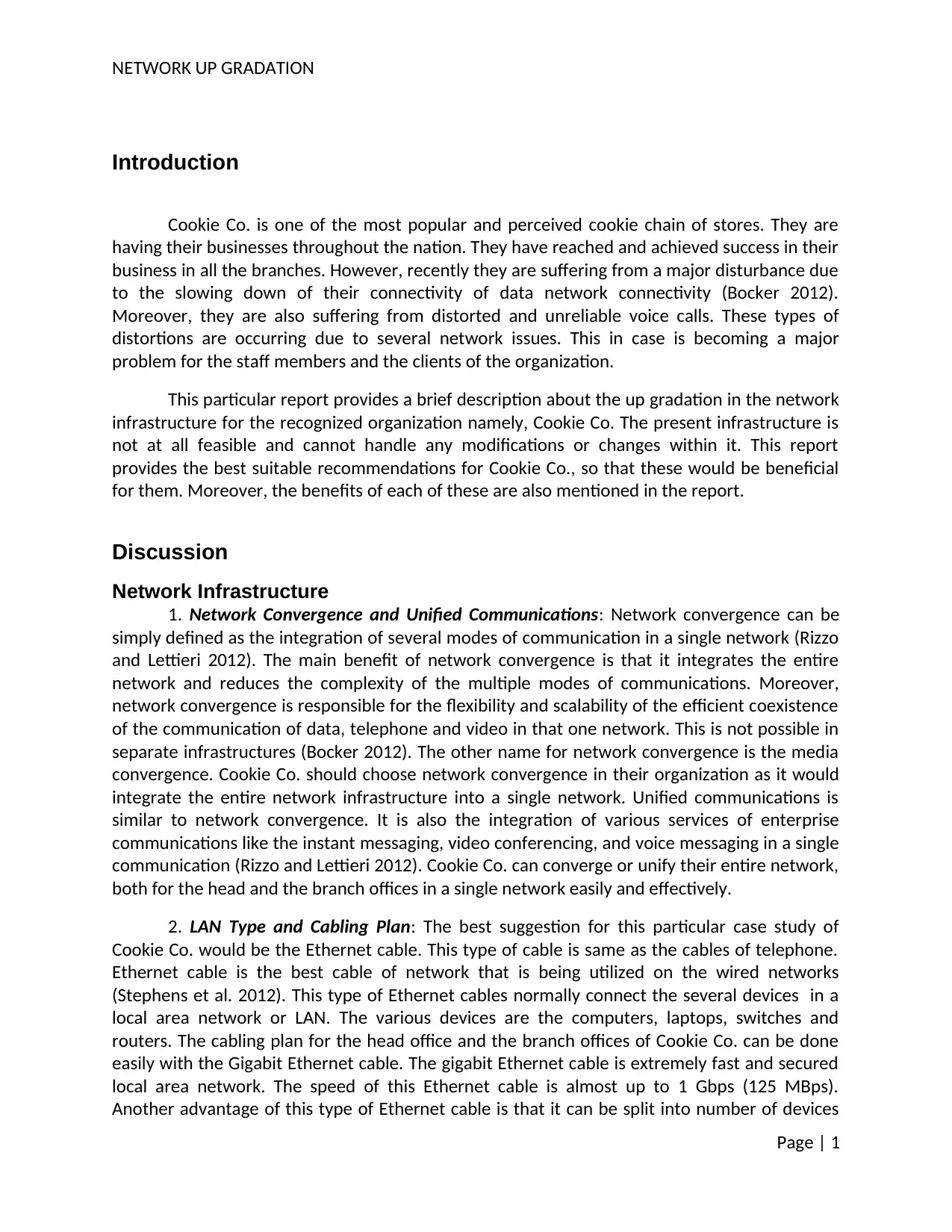
NETWORK UP GRADATION
Introduction
Cookie Co. is one of the most popular and perceived cookie chain of stores. They are
having their businesses throughout the nation. They have reached and achieved success in their
business in all the branches. However, recently they are suffering from a major disturbance due
to the slowing down of their connectivity of data network connectivity (Bocker 2012).
Moreover, they are also suffering from distorted and unreliable voice calls. These types of
distortions are occurring due to several network issues. This in case is becoming a major
problem for the staff members and the clients of the organization.
This particular report provides a brief description about the up gradation in the network
infrastructure for the recognized organization namely, Cookie Co. The present infrastructure is
not at all feasible and cannot handle any modifications or changes within it. This report
provides the best suitable recommendations for Cookie Co., so that these would be beneficial
for them. Moreover, the benefits of each of these are also mentioned in the report.
Discussion
Network Infrastructure
1. Network Convergence and Unified Communications: Network convergence can be
simply defined as the integration of several modes of communication in a single network (Rizzo
and Lettieri 2012). The main benefit of network convergence is that it integrates the entire
network and reduces the complexity of the multiple modes of communications. Moreover,
network convergence is responsible for the flexibility and scalability of the efficient coexistence
of the communication of data, telephone and video in that one network. This is not possible in
separate infrastructures (Bocker 2012). The other name for network convergence is the media
convergence. Cookie Co. should choose network convergence in their organization as it would
integrate the entire network infrastructure into a single network. Unified communications is
similar to network convergence. It is also the integration of various services of enterprise
communications like the instant messaging, video conferencing, and voice messaging in a single
communication (Rizzo and Lettieri 2012). Cookie Co. can converge or unify their entire network,
both for the head and the branch offices in a single network easily and effectively.
2. LAN Type and Cabling Plan: The best suggestion for this particular case study of
Cookie Co. would be the Ethernet cable. This type of cable is same as the cables of telephone.
Ethernet cable is the best cable of network that is being utilized on the wired networks
(Stephens et al. 2012). This type of Ethernet cables normally connect the several devices in a
local area network or LAN. The various devices are the computers, laptops, switches and
routers. The cabling plan for the head office and the branch offices of Cookie Co. can be done
easily with the Gigabit Ethernet cable. The gigabit Ethernet cable is extremely fast and secured
local area network. The speed of this Ethernet cable is almost up to 1 Gbps (125 MBps).
Another advantage of this type of Ethernet cable is that it can be split into number of devices
Page | 1
Introduction
Cookie Co. is one of the most popular and perceived cookie chain of stores. They are
having their businesses throughout the nation. They have reached and achieved success in their
business in all the branches. However, recently they are suffering from a major disturbance due
to the slowing down of their connectivity of data network connectivity (Bocker 2012).
Moreover, they are also suffering from distorted and unreliable voice calls. These types of
distortions are occurring due to several network issues. This in case is becoming a major
problem for the staff members and the clients of the organization.
This particular report provides a brief description about the up gradation in the network
infrastructure for the recognized organization namely, Cookie Co. The present infrastructure is
not at all feasible and cannot handle any modifications or changes within it. This report
provides the best suitable recommendations for Cookie Co., so that these would be beneficial
for them. Moreover, the benefits of each of these are also mentioned in the report.
Discussion
Network Infrastructure
1. Network Convergence and Unified Communications: Network convergence can be
simply defined as the integration of several modes of communication in a single network (Rizzo
and Lettieri 2012). The main benefit of network convergence is that it integrates the entire
network and reduces the complexity of the multiple modes of communications. Moreover,
network convergence is responsible for the flexibility and scalability of the efficient coexistence
of the communication of data, telephone and video in that one network. This is not possible in
separate infrastructures (Bocker 2012). The other name for network convergence is the media
convergence. Cookie Co. should choose network convergence in their organization as it would
integrate the entire network infrastructure into a single network. Unified communications is
similar to network convergence. It is also the integration of various services of enterprise
communications like the instant messaging, video conferencing, and voice messaging in a single
communication (Rizzo and Lettieri 2012). Cookie Co. can converge or unify their entire network,
both for the head and the branch offices in a single network easily and effectively.
2. LAN Type and Cabling Plan: The best suggestion for this particular case study of
Cookie Co. would be the Ethernet cable. This type of cable is same as the cables of telephone.
Ethernet cable is the best cable of network that is being utilized on the wired networks
(Stephens et al. 2012). This type of Ethernet cables normally connect the several devices in a
local area network or LAN. The various devices are the computers, laptops, switches and
routers. The cabling plan for the head office and the branch offices of Cookie Co. can be done
easily with the Gigabit Ethernet cable. The gigabit Ethernet cable is extremely fast and secured
local area network. The speed of this Ethernet cable is almost up to 1 Gbps (125 MBps).
Another advantage of this type of Ethernet cable is that it can be split into number of devices
Page | 1
Paraphrase This Document
Need a fresh take? Get an instant paraphrase of this document with our AI Paraphraser
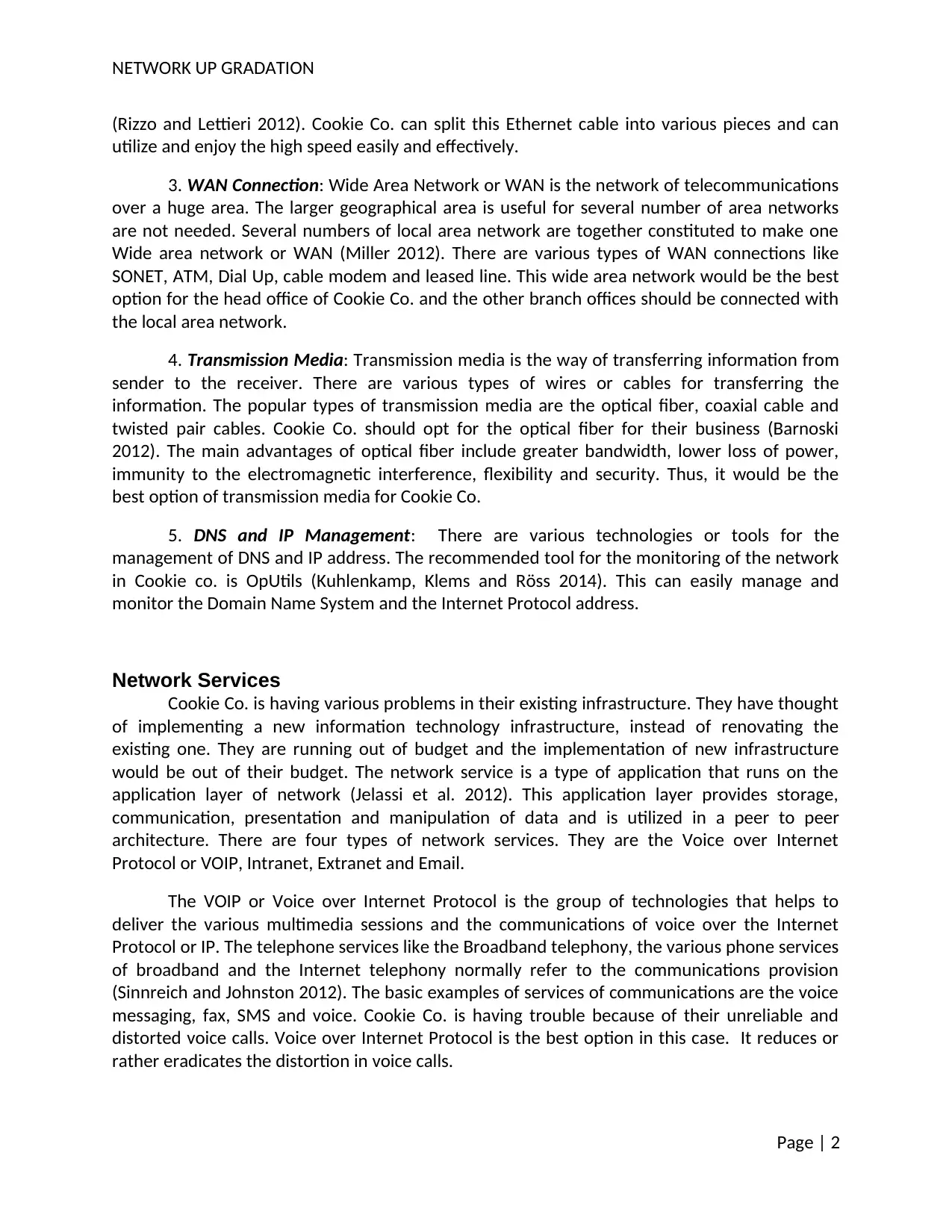
NETWORK UP GRADATION
(Rizzo and Lettieri 2012). Cookie Co. can split this Ethernet cable into various pieces and can
utilize and enjoy the high speed easily and effectively.
3. WAN Connection: Wide Area Network or WAN is the network of telecommunications
over a huge area. The larger geographical area is useful for several number of area networks
are not needed. Several numbers of local area network are together constituted to make one
Wide area network or WAN (Miller 2012). There are various types of WAN connections like
SONET, ATM, Dial Up, cable modem and leased line. This wide area network would be the best
option for the head office of Cookie Co. and the other branch offices should be connected with
the local area network.
4. Transmission Media: Transmission media is the way of transferring information from
sender to the receiver. There are various types of wires or cables for transferring the
information. The popular types of transmission media are the optical fiber, coaxial cable and
twisted pair cables. Cookie Co. should opt for the optical fiber for their business (Barnoski
2012). The main advantages of optical fiber include greater bandwidth, lower loss of power,
immunity to the electromagnetic interference, flexibility and security. Thus, it would be the
best option of transmission media for Cookie Co.
5. DNS and IP Management: There are various technologies or tools for the
management of DNS and IP address. The recommended tool for the monitoring of the network
in Cookie co. is OpUtils (Kuhlenkamp, Klems and Röss 2014). This can easily manage and
monitor the Domain Name System and the Internet Protocol address.
Network Services
Cookie Co. is having various problems in their existing infrastructure. They have thought
of implementing a new information technology infrastructure, instead of renovating the
existing one. They are running out of budget and the implementation of new infrastructure
would be out of their budget. The network service is a type of application that runs on the
application layer of network (Jelassi et al. 2012). This application layer provides storage,
communication, presentation and manipulation of data and is utilized in a peer to peer
architecture. There are four types of network services. They are the Voice over Internet
Protocol or VOIP, Intranet, Extranet and Email.
The VOIP or Voice over Internet Protocol is the group of technologies that helps to
deliver the various multimedia sessions and the communications of voice over the Internet
Protocol or IP. The telephone services like the Broadband telephony, the various phone services
of broadband and the Internet telephony normally refer to the communications provision
(Sinnreich and Johnston 2012). The basic examples of services of communications are the voice
messaging, fax, SMS and voice. Cookie Co. is having trouble because of their unreliable and
distorted voice calls. Voice over Internet Protocol is the best option in this case. It reduces or
rather eradicates the distortion in voice calls.
Page | 2
(Rizzo and Lettieri 2012). Cookie Co. can split this Ethernet cable into various pieces and can
utilize and enjoy the high speed easily and effectively.
3. WAN Connection: Wide Area Network or WAN is the network of telecommunications
over a huge area. The larger geographical area is useful for several number of area networks
are not needed. Several numbers of local area network are together constituted to make one
Wide area network or WAN (Miller 2012). There are various types of WAN connections like
SONET, ATM, Dial Up, cable modem and leased line. This wide area network would be the best
option for the head office of Cookie Co. and the other branch offices should be connected with
the local area network.
4. Transmission Media: Transmission media is the way of transferring information from
sender to the receiver. There are various types of wires or cables for transferring the
information. The popular types of transmission media are the optical fiber, coaxial cable and
twisted pair cables. Cookie Co. should opt for the optical fiber for their business (Barnoski
2012). The main advantages of optical fiber include greater bandwidth, lower loss of power,
immunity to the electromagnetic interference, flexibility and security. Thus, it would be the
best option of transmission media for Cookie Co.
5. DNS and IP Management: There are various technologies or tools for the
management of DNS and IP address. The recommended tool for the monitoring of the network
in Cookie co. is OpUtils (Kuhlenkamp, Klems and Röss 2014). This can easily manage and
monitor the Domain Name System and the Internet Protocol address.
Network Services
Cookie Co. is having various problems in their existing infrastructure. They have thought
of implementing a new information technology infrastructure, instead of renovating the
existing one. They are running out of budget and the implementation of new infrastructure
would be out of their budget. The network service is a type of application that runs on the
application layer of network (Jelassi et al. 2012). This application layer provides storage,
communication, presentation and manipulation of data and is utilized in a peer to peer
architecture. There are four types of network services. They are the Voice over Internet
Protocol or VOIP, Intranet, Extranet and Email.
The VOIP or Voice over Internet Protocol is the group of technologies that helps to
deliver the various multimedia sessions and the communications of voice over the Internet
Protocol or IP. The telephone services like the Broadband telephony, the various phone services
of broadband and the Internet telephony normally refer to the communications provision
(Sinnreich and Johnston 2012). The basic examples of services of communications are the voice
messaging, fax, SMS and voice. Cookie Co. is having trouble because of their unreliable and
distorted voice calls. Voice over Internet Protocol is the best option in this case. It reduces or
rather eradicates the distortion in voice calls.
Page | 2
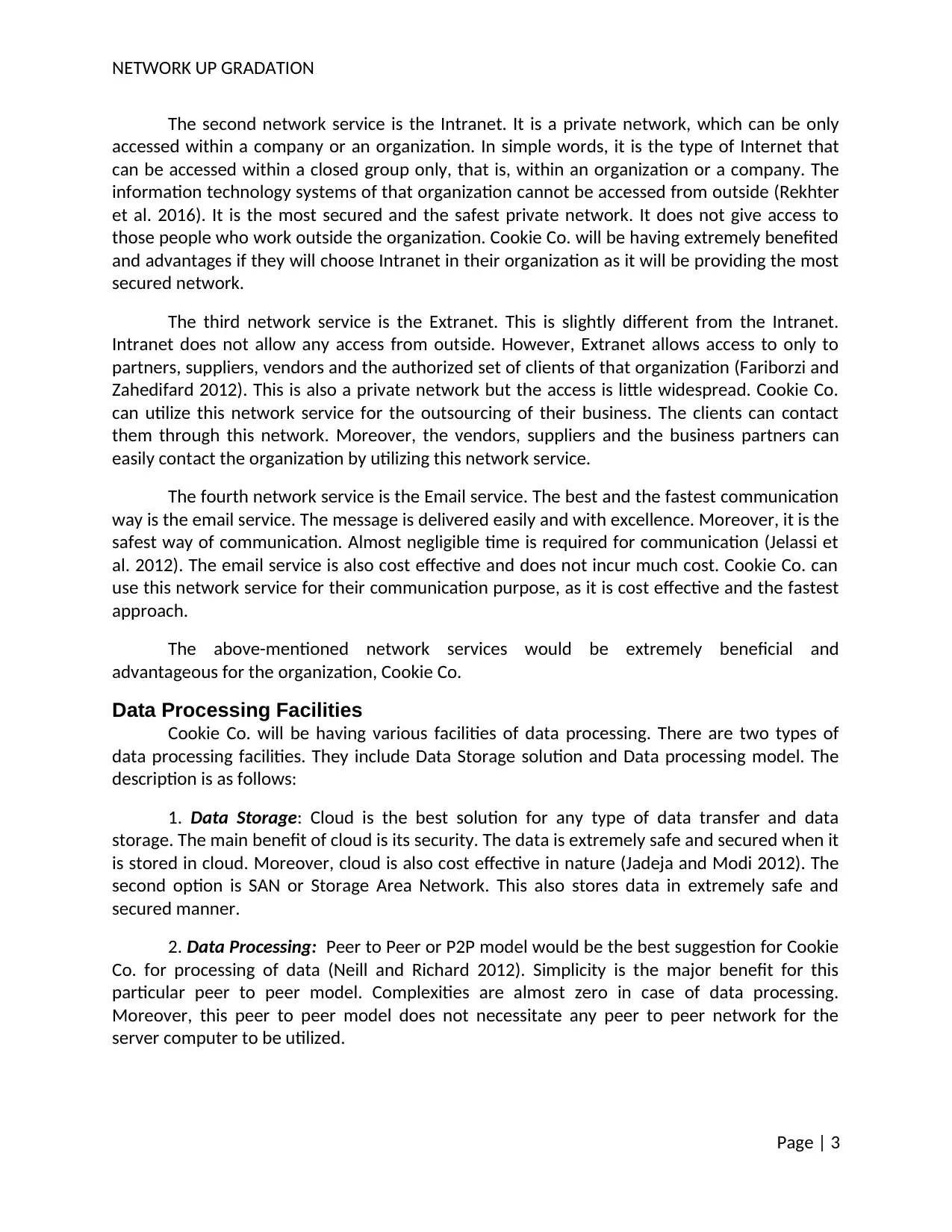
NETWORK UP GRADATION
The second network service is the Intranet. It is a private network, which can be only
accessed within a company or an organization. In simple words, it is the type of Internet that
can be accessed within a closed group only, that is, within an organization or a company. The
information technology systems of that organization cannot be accessed from outside (Rekhter
et al. 2016). It is the most secured and the safest private network. It does not give access to
those people who work outside the organization. Cookie Co. will be having extremely benefited
and advantages if they will choose Intranet in their organization as it will be providing the most
secured network.
The third network service is the Extranet. This is slightly different from the Intranet.
Intranet does not allow any access from outside. However, Extranet allows access to only to
partners, suppliers, vendors and the authorized set of clients of that organization (Fariborzi and
Zahedifard 2012). This is also a private network but the access is little widespread. Cookie Co.
can utilize this network service for the outsourcing of their business. The clients can contact
them through this network. Moreover, the vendors, suppliers and the business partners can
easily contact the organization by utilizing this network service.
The fourth network service is the Email service. The best and the fastest communication
way is the email service. The message is delivered easily and with excellence. Moreover, it is the
safest way of communication. Almost negligible time is required for communication (Jelassi et
al. 2012). The email service is also cost effective and does not incur much cost. Cookie Co. can
use this network service for their communication purpose, as it is cost effective and the fastest
approach.
The above-mentioned network services would be extremely beneficial and
advantageous for the organization, Cookie Co.
Data Processing Facilities
Cookie Co. will be having various facilities of data processing. There are two types of
data processing facilities. They include Data Storage solution and Data processing model. The
description is as follows:
1. Data Storage: Cloud is the best solution for any type of data transfer and data
storage. The main benefit of cloud is its security. The data is extremely safe and secured when it
is stored in cloud. Moreover, cloud is also cost effective in nature (Jadeja and Modi 2012). The
second option is SAN or Storage Area Network. This also stores data in extremely safe and
secured manner.
2. Data Processing: Peer to Peer or P2P model would be the best suggestion for Cookie
Co. for processing of data (Neill and Richard 2012). Simplicity is the major benefit for this
particular peer to peer model. Complexities are almost zero in case of data processing.
Moreover, this peer to peer model does not necessitate any peer to peer network for the
server computer to be utilized.
Page | 3
The second network service is the Intranet. It is a private network, which can be only
accessed within a company or an organization. In simple words, it is the type of Internet that
can be accessed within a closed group only, that is, within an organization or a company. The
information technology systems of that organization cannot be accessed from outside (Rekhter
et al. 2016). It is the most secured and the safest private network. It does not give access to
those people who work outside the organization. Cookie Co. will be having extremely benefited
and advantages if they will choose Intranet in their organization as it will be providing the most
secured network.
The third network service is the Extranet. This is slightly different from the Intranet.
Intranet does not allow any access from outside. However, Extranet allows access to only to
partners, suppliers, vendors and the authorized set of clients of that organization (Fariborzi and
Zahedifard 2012). This is also a private network but the access is little widespread. Cookie Co.
can utilize this network service for the outsourcing of their business. The clients can contact
them through this network. Moreover, the vendors, suppliers and the business partners can
easily contact the organization by utilizing this network service.
The fourth network service is the Email service. The best and the fastest communication
way is the email service. The message is delivered easily and with excellence. Moreover, it is the
safest way of communication. Almost negligible time is required for communication (Jelassi et
al. 2012). The email service is also cost effective and does not incur much cost. Cookie Co. can
use this network service for their communication purpose, as it is cost effective and the fastest
approach.
The above-mentioned network services would be extremely beneficial and
advantageous for the organization, Cookie Co.
Data Processing Facilities
Cookie Co. will be having various facilities of data processing. There are two types of
data processing facilities. They include Data Storage solution and Data processing model. The
description is as follows:
1. Data Storage: Cloud is the best solution for any type of data transfer and data
storage. The main benefit of cloud is its security. The data is extremely safe and secured when it
is stored in cloud. Moreover, cloud is also cost effective in nature (Jadeja and Modi 2012). The
second option is SAN or Storage Area Network. This also stores data in extremely safe and
secured manner.
2. Data Processing: Peer to Peer or P2P model would be the best suggestion for Cookie
Co. for processing of data (Neill and Richard 2012). Simplicity is the major benefit for this
particular peer to peer model. Complexities are almost zero in case of data processing.
Moreover, this peer to peer model does not necessitate any peer to peer network for the
server computer to be utilized.
Page | 3
⊘ This is a preview!⊘
Do you want full access?
Subscribe today to unlock all pages.

Trusted by 1+ million students worldwide
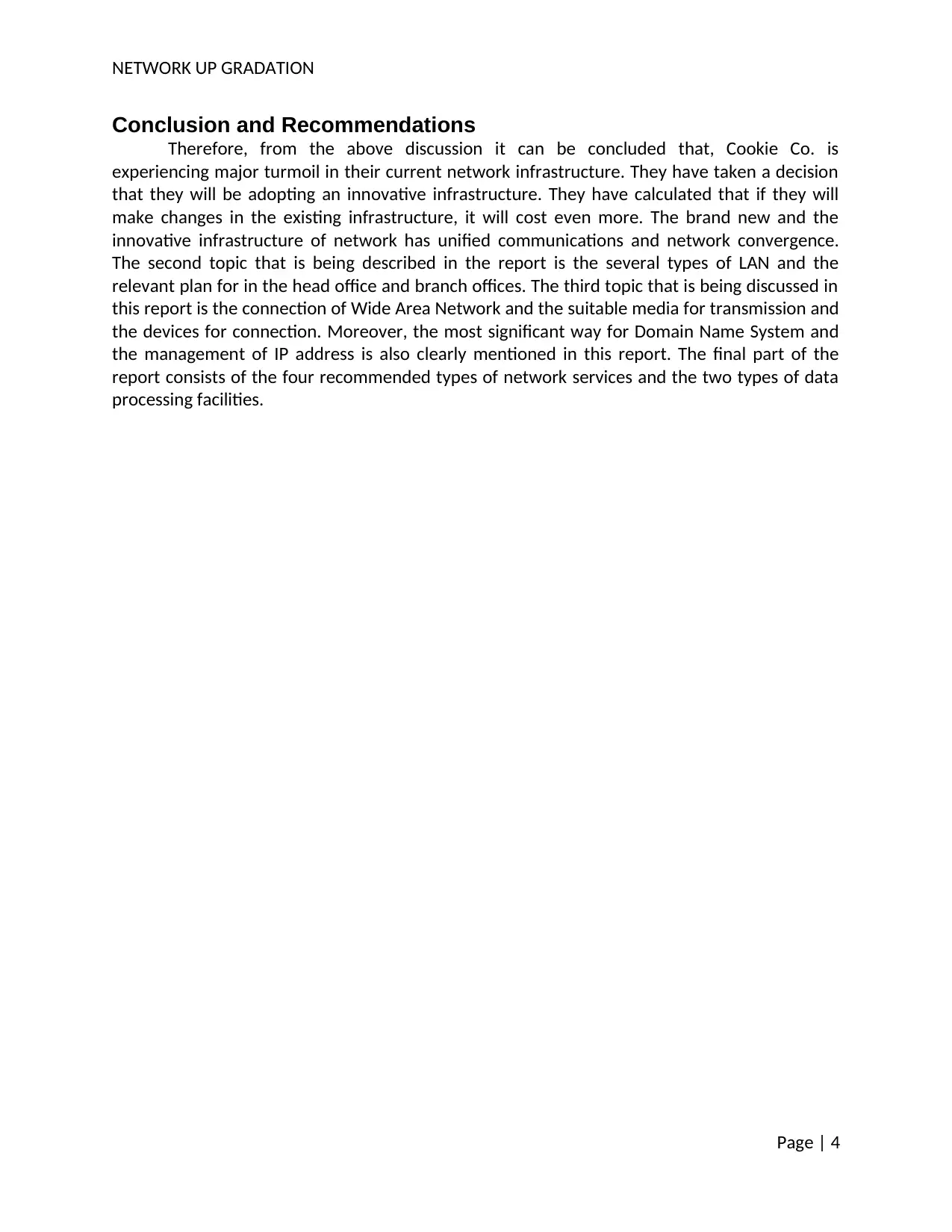
NETWORK UP GRADATION
Conclusion and Recommendations
Therefore, from the above discussion it can be concluded that, Cookie Co. is
experiencing major turmoil in their current network infrastructure. They have taken a decision
that they will be adopting an innovative infrastructure. They have calculated that if they will
make changes in the existing infrastructure, it will cost even more. The brand new and the
innovative infrastructure of network has unified communications and network convergence.
The second topic that is being described in the report is the several types of LAN and the
relevant plan for in the head office and branch offices. The third topic that is being discussed in
this report is the connection of Wide Area Network and the suitable media for transmission and
the devices for connection. Moreover, the most significant way for Domain Name System and
the management of IP address is also clearly mentioned in this report. The final part of the
report consists of the four recommended types of network services and the two types of data
processing facilities.
Page | 4
Conclusion and Recommendations
Therefore, from the above discussion it can be concluded that, Cookie Co. is
experiencing major turmoil in their current network infrastructure. They have taken a decision
that they will be adopting an innovative infrastructure. They have calculated that if they will
make changes in the existing infrastructure, it will cost even more. The brand new and the
innovative infrastructure of network has unified communications and network convergence.
The second topic that is being described in the report is the several types of LAN and the
relevant plan for in the head office and branch offices. The third topic that is being discussed in
this report is the connection of Wide Area Network and the suitable media for transmission and
the devices for connection. Moreover, the most significant way for Domain Name System and
the management of IP address is also clearly mentioned in this report. The final part of the
report consists of the four recommended types of network services and the two types of data
processing facilities.
Page | 4
Paraphrase This Document
Need a fresh take? Get an instant paraphrase of this document with our AI Paraphraser
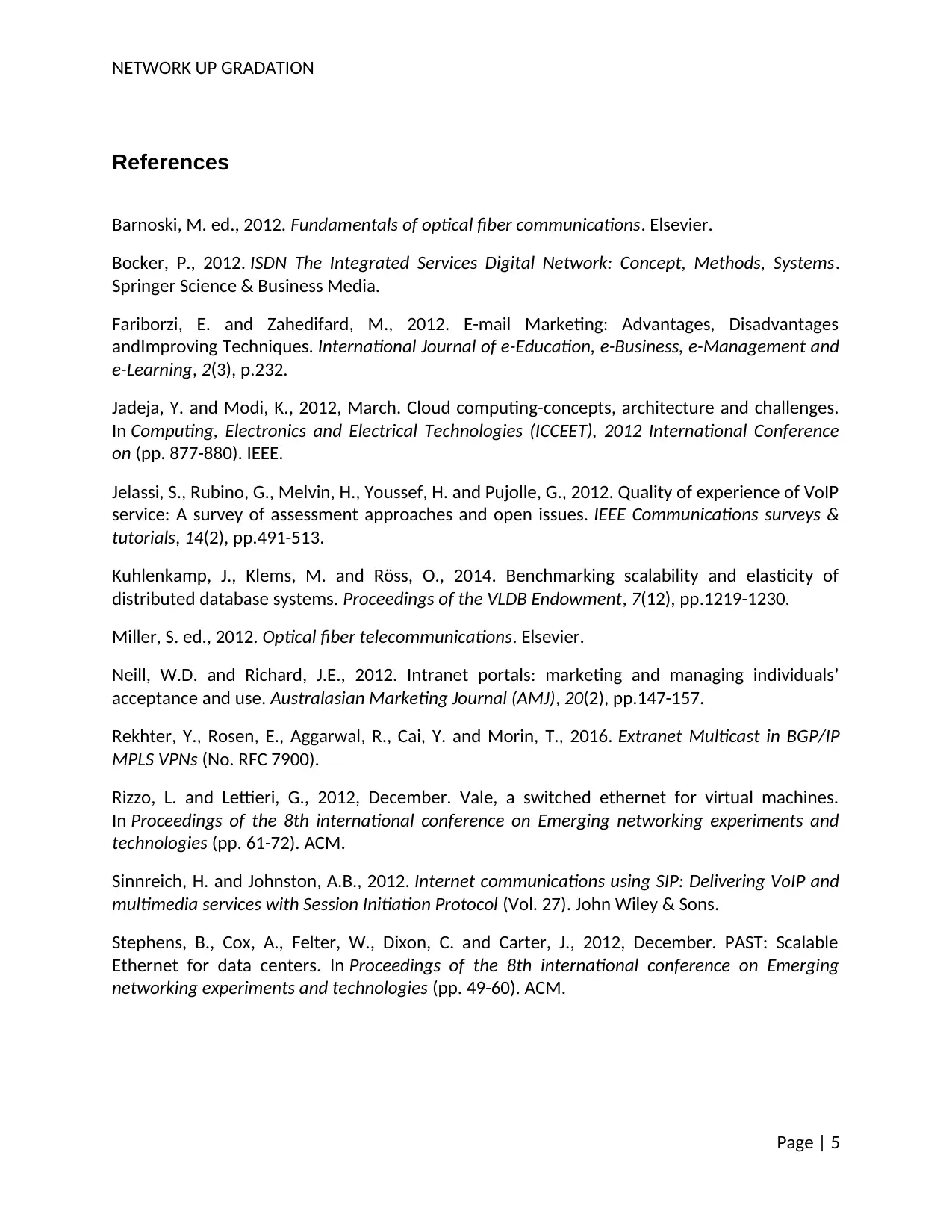
NETWORK UP GRADATION
References
Barnoski, M. ed., 2012. Fundamentals of optical fiber communications. Elsevier.
Bocker, P., 2012. ISDN The Integrated Services Digital Network: Concept, Methods, Systems.
Springer Science & Business Media.
Fariborzi, E. and Zahedifard, M., 2012. E-mail Marketing: Advantages, Disadvantages
andImproving Techniques. International Journal of e-Education, e-Business, e-Management and
e-Learning, 2(3), p.232.
Jadeja, Y. and Modi, K., 2012, March. Cloud computing-concepts, architecture and challenges.
In Computing, Electronics and Electrical Technologies (ICCEET), 2012 International Conference
on (pp. 877-880). IEEE.
Jelassi, S., Rubino, G., Melvin, H., Youssef, H. and Pujolle, G., 2012. Quality of experience of VoIP
service: A survey of assessment approaches and open issues. IEEE Communications surveys &
tutorials, 14(2), pp.491-513.
Kuhlenkamp, J., Klems, M. and Röss, O., 2014. Benchmarking scalability and elasticity of
distributed database systems. Proceedings of the VLDB Endowment, 7(12), pp.1219-1230.
Miller, S. ed., 2012. Optical fiber telecommunications. Elsevier.
Neill, W.D. and Richard, J.E., 2012. Intranet portals: marketing and managing individuals’
acceptance and use. Australasian Marketing Journal (AMJ), 20(2), pp.147-157.
Rekhter, Y., Rosen, E., Aggarwal, R., Cai, Y. and Morin, T., 2016. Extranet Multicast in BGP/IP
MPLS VPNs (No. RFC 7900).
Rizzo, L. and Lettieri, G., 2012, December. Vale, a switched ethernet for virtual machines.
In Proceedings of the 8th international conference on Emerging networking experiments and
technologies (pp. 61-72). ACM.
Sinnreich, H. and Johnston, A.B., 2012. Internet communications using SIP: Delivering VoIP and
multimedia services with Session Initiation Protocol (Vol. 27). John Wiley & Sons.
Stephens, B., Cox, A., Felter, W., Dixon, C. and Carter, J., 2012, December. PAST: Scalable
Ethernet for data centers. In Proceedings of the 8th international conference on Emerging
networking experiments and technologies (pp. 49-60). ACM.
Page | 5
References
Barnoski, M. ed., 2012. Fundamentals of optical fiber communications. Elsevier.
Bocker, P., 2012. ISDN The Integrated Services Digital Network: Concept, Methods, Systems.
Springer Science & Business Media.
Fariborzi, E. and Zahedifard, M., 2012. E-mail Marketing: Advantages, Disadvantages
andImproving Techniques. International Journal of e-Education, e-Business, e-Management and
e-Learning, 2(3), p.232.
Jadeja, Y. and Modi, K., 2012, March. Cloud computing-concepts, architecture and challenges.
In Computing, Electronics and Electrical Technologies (ICCEET), 2012 International Conference
on (pp. 877-880). IEEE.
Jelassi, S., Rubino, G., Melvin, H., Youssef, H. and Pujolle, G., 2012. Quality of experience of VoIP
service: A survey of assessment approaches and open issues. IEEE Communications surveys &
tutorials, 14(2), pp.491-513.
Kuhlenkamp, J., Klems, M. and Röss, O., 2014. Benchmarking scalability and elasticity of
distributed database systems. Proceedings of the VLDB Endowment, 7(12), pp.1219-1230.
Miller, S. ed., 2012. Optical fiber telecommunications. Elsevier.
Neill, W.D. and Richard, J.E., 2012. Intranet portals: marketing and managing individuals’
acceptance and use. Australasian Marketing Journal (AMJ), 20(2), pp.147-157.
Rekhter, Y., Rosen, E., Aggarwal, R., Cai, Y. and Morin, T., 2016. Extranet Multicast in BGP/IP
MPLS VPNs (No. RFC 7900).
Rizzo, L. and Lettieri, G., 2012, December. Vale, a switched ethernet for virtual machines.
In Proceedings of the 8th international conference on Emerging networking experiments and
technologies (pp. 61-72). ACM.
Sinnreich, H. and Johnston, A.B., 2012. Internet communications using SIP: Delivering VoIP and
multimedia services with Session Initiation Protocol (Vol. 27). John Wiley & Sons.
Stephens, B., Cox, A., Felter, W., Dixon, C. and Carter, J., 2012, December. PAST: Scalable
Ethernet for data centers. In Proceedings of the 8th international conference on Emerging
networking experiments and technologies (pp. 49-60). ACM.
Page | 5
1 out of 8
Related Documents
Your All-in-One AI-Powered Toolkit for Academic Success.
+13062052269
info@desklib.com
Available 24*7 on WhatsApp / Email
![[object Object]](/_next/static/media/star-bottom.7253800d.svg)
Unlock your academic potential
Copyright © 2020–2025 A2Z Services. All Rights Reserved. Developed and managed by ZUCOL.





